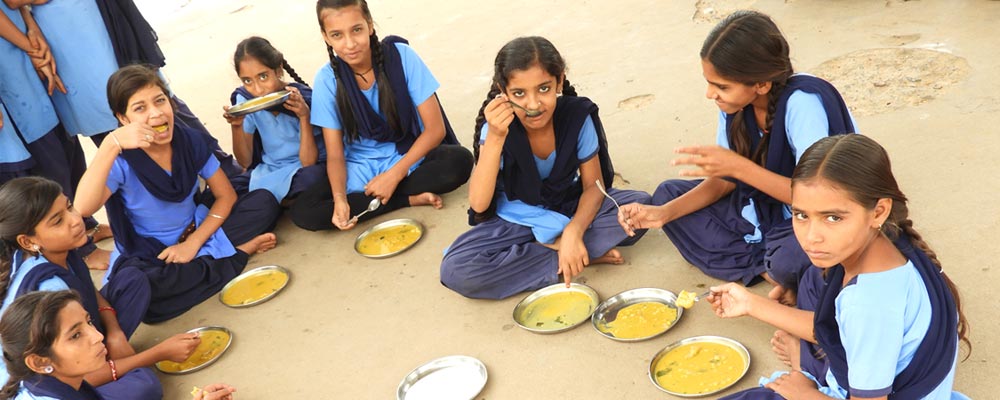52.8 million Urban population living below the official poverty line (Planning Commission, 2013)*. Urban poverty is extremely dynamic and complex and is rooted in the increasing urbanization and rural-urban migration. While cities are often considered as places of opportunity, they also create and feed conditions in which poverty spreads. Urban poor are unable to access benefits available in cities relate to access to housing, humane working conditions, access to basic amenities such as safe drinking water, affordable quality education, nutritious food and health care due to lack of information and knowledge on their rights and entitlements most often continue to be derived from the basic citizenry rights they deserved. On the other hand, city administrations are unable or unwilling to address these issues.
Urban Poverty and food insecurities are parallel phenomena. In pace of increasing urbanization, the situation of food and nutrition security in urban areas is often overlooked. About half the women and children in urban areas are estimated to be anemic and undernutrition. In spite of the rapid economic growth during the 1990s, the access and absorption indicators of urban food insecurity reveal an alarming picture. Smaller towns are significantly worse off than large cities and metropolitan areas when it comes to key food security indicators. Urban food insecurity deserves serious attention since an important component of urbanization is the proliferation of slums caused by the unplanned migration of the rural poor to urban areas in search of livelihoods.
The three major flagship interventions of the government, namely, the public distribution system (PDS), the national programme of nutritional support to education more commonly known as the mid-day meal scheme (MDMS) and the integrated child development services (ICDS) has made significant contribution to improving the food insecurities amongst both rural and urban poor in the country. Poverty Alleviation programmes are designed such a way that citizens can observe and scrutinize the performance. However, the benefits of the schemes hardly reached to the poor due to inefficiency and corruption.
Historically, India’s Public Distribution System (PDS) is the largest distribution network of its kind in the world. PDS was introduced around World War II as a war-time rationing measure. In the 1990s, the scheme was revamped to improve access to food grains to people in hilly and inaccessible areas, and to target the poor. Subsequently, in 1997, the government launched the Targeted Public Distribution System (TPDS), aims to provide subsidized food and fuel to the poor through a network of ration shops. In September 2013, Parliament enacted the National Food Security Act, 2013. The Act relies largely on the existing TPDS to deliver food grains as legal entitlements to poor households. This marks a shift by making the right to food a justifiable right. Eligible beneficiaries are entitled to subsidized food grains minimum of 5 kg per person per month such as wheat at Rs. 2/- per kg; rice Rs. 3/- per kg and coarse grains at Re. 1/- per kg.States have the discretion to provide other commodities such as sugar, kerosene, and fortified flour under TPDS.
The National Programme of Nutritional Support to Primary Education (NPNSPE), popularly known as the Mid-Day Meal Scheme (MDMS), started by the Government of India in 1995, seeks to improve the nutritional status of children in studying in class I-VIII in schools or education centers. The scheme initially provided for distribution of fixed quantities of dry food grains to schoolchildren. This was replaced by cooked meals with effect from September 2004. While the scheme has had a significant positive impact on enrolment and retention across the country, concurrent monitoring and evaluation systems of a participatory nature need to be strengthened to ensure better delivery.
The Integrated Child Development Services (ICDS) scheme launched in 1975 aims at holistic development of children up to six years of age as well as adolescent girls and pregnant and lactating mothers by providing a package of services comprising supplementary nutrition, immunisation, health check-up, referral services, non-formal pre-school education and health and nutrition education. The services under ICDS are offered through a network of Anaganwadi centres. A report from MS Swaminathan Research Foundation (MSSRF) in 2010 suggests, as on 31 March 2009, around 1 million Anaganwadi centres were in operation in the country, covering around 72 million children in the 6 months to 6 years age group as well as 15 million pregnant women and lactating mothers under the supplementary nutrition programme.
In order to ensure rights and entitlements of poor women and children residing in informal settlements in Bhuj city, SakhiSangini, a Bhuj based women’s federation actively working on women’s issues to ensure socio-political and economic empowerment, basic entitlements and social justice for poor women in the society, has initiated monitoring of service delivery of these public schemes so as to ensure efficient service delivery and enable underprivileged segment of urban society to access the benefits of schemes designed for them.
* The Planning Commission, Poverty estimate for 2011-12 (based on the Tendulkar method).
EDUCATION: DESIRE FOR STUDY

